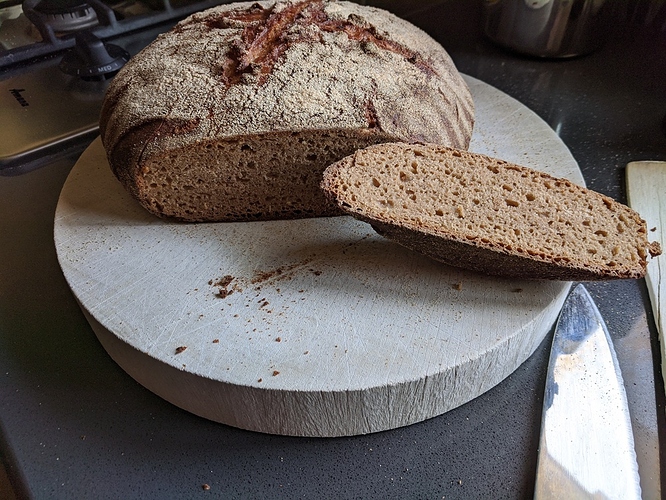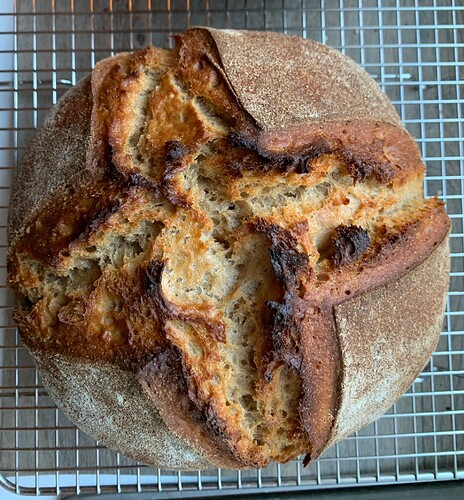I followed this recipe with variation provided by Dan (dst307), my Emmer flour came from Bluebird. I didn’t know using a small amount of starter was so key! I also used only 2 TBSP of honey. I aimed for 70% hydration and found still the dough very difficult to work with despite adding a large amount of flour during bulk ferment turnovers.
Another key was to soak the flour, water, and salt mixture first in the refrigerator, then taking out to warm overnight, and then innoculate with the separately developed starter. From just 1 tsp from my mother starter batch (plus several tsp emmer flour and water), I was careful to not let it go beyond 12 hours. In fact, I got concerned about too much time on the first starter batch (It would be 14 hours the next morning), I did a second stage with a tsp from the first before nighttime so it would be ready in the morning at 8 hours to merge with the warmed bulk mix.
A few hours into bulk, the mixture was very pliable and “window pane”-ing, I kept adding flour to make it easier to handle but to no avail, and 6 hours into bulk it had doubled in size, looked spongy, I tried to fold it, but it was still too wet to handle and I ended up deflating it instead. After 2 more hours of bulk ferment ( 8 hours total), I moved it to an oblong basket lined with rice flour and I wasn’t able to get much surface tension in forming since it was too wet to handle easily. I proofed for 3 hours in a warmed oven where it grew to just over double in size recovering the loss in volume. I put into an oblong covered baking clouch, slashed, removing lid per recipe until the final 10 minutes, measured 205F. I didn’t get much over spring, I figured I should have proofed 2 hours earlier? However, the crumb presented itself with a nice, tender web of holes and not too dense.
The taste ended up a bit nutty and not bitter like whole wheat flour. It resembles the Danish rye breakfast bread, but milder in flavor and more delicate texture and not so dark in color. My loaf had a distinct and strong sour flavor, almost as if sheep’s milk yogurt was spread on it. I would slice 1/4 inch thick pieces off, cut in half and enjoy without butter, cheese or jam! Of course, some feta cheese was nice too with it, but not necessary as the flavor of the bread with the sharp sourness was complex and delightful by itself. But with feta and enjoyed with my favorite tea, the nice aftertaste of the combined sourdough Emmer wheat bread and cheese would linger for hours in my mouth.
I attribute this strong and sour flavor to the unusual care I used for the starter, I usually just throw in directly from the mother batch from the refrigerator, but now I’ve learned to take only a teaspoon and develop it, and in my case using a 2-stage process to strengthen it before merging it to the bulk mix that has soaked overnight.
I will try again, perhaps cutting way back on the hydration and add water until it’s just barely manageable to handle. This is a nice change-up in sourdough baking to use Emmer flour instead of standard whole wheat, and I’m sure this territory can be explored further by varying processes and techniques to achieve some other unique bread characteristics. What fun this has been!
-Mathew S.
 I must admit my flour is particularly finely ground! That could be a problem!
I must admit my flour is particularly finely ground! That could be a problem!





